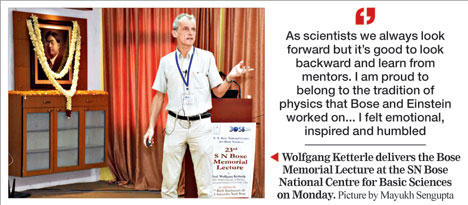
Calcutta: Physics Nobel laureate Wolfgang Ketterle, who observed and studied the Bose-Einstein condensate (BEC), a phase of matter, feels humbled visiting the city of his mentor.
"As scientists we always look forward but it's good to look backward and learn from mentors. I am proud to belong to the tradition of physics that Bose and Einstein worked on. Last time, I was here I visited the house where Bose lived. I felt emotional, inspired and humbled," said the tall and lanky German physicist, who shared the 2001 Physics Nobel with Eric Cornell and Carl Weiman.
Ketterle was in the city to deliver the Bose Memorial Lecture at the SN Bose National Centre for Basic Sciences on the occasion of Satyendranath Bose's 125th birth anniversary.
Bose - a fellow of the Royal Society - had specialised in quantum mechanics in the early 1920s, providing the foundation for Bose-Einstein statistics and the theory of the Bose-Einstein condensate.
The particles that obey the Bose-Einstein statistics have been named after him as bosons. A man with varied interests, Bose was a self-taught scholar and linguist who also dabbled in philosophy, arts, literature and music.
In 1924, Bose and Einstein published a series of papers that said that if a collection of bosonic atoms could be cooled to the point that each one reached its lowest possible quantum mechanical energy, a Bose-Einstein condensate (BEC) would result. In this state, atoms would lose their individual properties and would act collectively as a single entity. In 1995, a group led by Eric Cornell and Carl Weiman at the National Institute of Standards and Technology in Boulder produced the world's first true BEC. Later that year, Ketterle and his group at Massachusetts Institute of Technology produced a BEC with a higher density.
The John D. MacArthur Professor of Physics at MIT, Ketterle, traps and cools atoms to temperatures close to absolute zero, and while doing that he stumbles on new forms of matter.
"Why do physicists freeze matter to extremely low temperatures? Why is it worthwhile to cool to temperatures which are a billion times lower than that of interstellar space?" he asked before demonstrating phenomena at low temperature that could lead to creation of new forms of matter.
Ketterle spoke about superfluids that can flow without dissipation. "Recently, we have observed a supersolid, which is gaseous, liquid and solid at the same time."
Such materials, the scientist said, could be used to make more powerful computers. "This creates a lot of excitement in quantum science, basic research that pushes towards quantum technologies, quantum simulation, quantum communication, quantum sensors and quantum computation," said Ketterle.
Research done on ultra-cold atoms has major thrusts on precision measurement in atomic physics, high-precision atoms and molecules that could build atomic clocks. "This is truly revolutionary and has wide applications in geological sciences," said the physicist.
Atomic clocks could predict tectonic shifts and geological deposits as they take into account the gravitational force. "For example," he said, "if there was an atomic clock in China and one in India, and if the earth changes, you could measure it with the clock".

